UPDATES
Two New Species of Dinosaurs Discovered In China; First of their Kind to Be Unearthed In the Region [Study]An international team of researchers announced the discovery of new dinosaur species at the Hami Pterosaur Fauna in China, and have been dated to the Early Cretaceous period (around 130 to 120 million years ago).
By Jeevan Biswas
August 15, 2021
Despite going extinct millions of years ago, dinosaurs command the admiration of human beings. At least for most millennials, Jurassic Park played a role in it. And the discovery of a new dinosaur every now and then continues to keep the excitement alive. Now, scientists have reported the discovery of not one but three new species in Northwest China, two of which are giants.
In a new international study, researchers announced the unearthing fossils of three new dinosaur species at the Hami Pterosaur Fauna in China. Of these, two have been christened Silutitan sinensis and Hamititan xinjiangensi, and have been dated to the Early Cretaceous period (around 130 to 120 million years ago). They are believed to be the first non-pterosaur vertebrates discovered in the area.
"These dinosaurs are the first vertebrates reported in this region, increasing the diversity of the fauna as well as the information on Chinese sauropods, further supporting a widespread diversification of somphospondylans during the Early Cretaceous of Asia," the authors wrote.
First Non-Pterosaurs In the Area
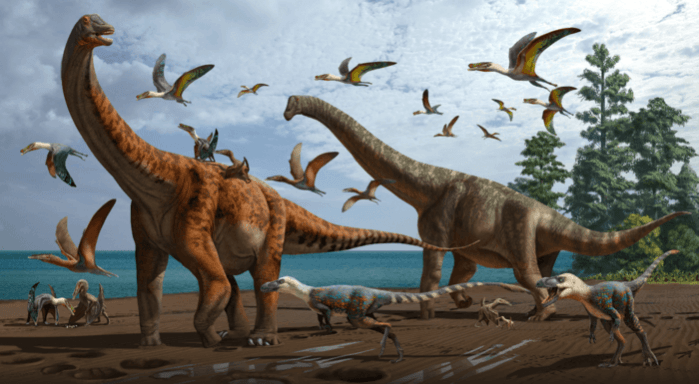
Artistic rendering of the palaeoecology of the Hami Pterosaur Fauna, with Silutitan sinensis on the left and Hamititan xinjiangensis on the right
ZHAO CHUANG AND WANG XIAOLIN
The newly identified species are the first vertebrates that are not pterosaurs to be unearthed at the Early Cretaceous Hami Pterosaur Fauna, China. It is the largest locality in the world with pterosaur fossils, and also the most abundant. Several three-dimensionally preserved male and female pterosaurs, and pterosaur eggs, have been uncovered in this area. The three specimens were located around 2-5 km away from each other.
Both the new species are said to belong to a subgroup or clade of dinosaurs known as Sauropoda (particularly within the clade Somphospondyli), whose members are called sauropods. The popular Brachiosaurus from the Jurassic Park franchise is an example of a sauropod. Along with the distinctive tails and large bodies, they were also known to have small heads and thick column-like legs. They are considered to be among the largest land-living animals to have existed, who reached lengths of 5m-40m (16ft-135ft) and weights of up to 70 tons (around 64,000 kgs).
Massive Sauropods Identified
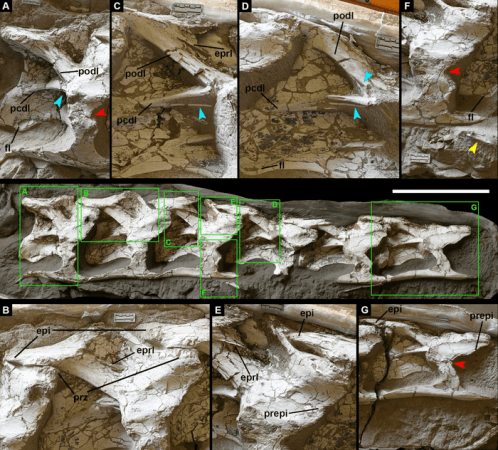
Holotype of Silutitan sinensis gen. et sp. novIVPP
The first newly identified species was named Silutitan sinensis. A joined series of six cervical vertebrae—from the 10th to 15th was preserved in the discovered specimen. Each of the vertebras was between 455–540 mm in length. It was observed that some of the features of its neck vertebrate suggested that it is from a family of sauropods called Euhelopodidae.
All known euhelopodids have been discovered only in Asia so far, particularly in East Asia. The specimen was compared to other dinosaurs that the authors believe were a closely related group, or from the genus Euhelopus. They approximated that this specimen's length was originally over 20 m (65ft). An incomplete lower jaw belonging to a pterosaur, Hamipterus tianshanensis, was found along with the Silutitan sinensis specimen.
The newly identified species are the first vertebrates that are not pterosaurs to be unearthed at the Early Cretaceous Hami Pterosaur Fauna, China. It is the largest locality in the world with pterosaur fossils, and also the most abundant. Several three-dimensionally preserved male and female pterosaurs, and pterosaur eggs, have been uncovered in this area. The three specimens were located around 2-5 km away from each other.
Both the new species are said to belong to a subgroup or clade of dinosaurs known as Sauropoda (particularly within the clade Somphospondyli), whose members are called sauropods. The popular Brachiosaurus from the Jurassic Park franchise is an example of a sauropod. Along with the distinctive tails and large bodies, they were also known to have small heads and thick column-like legs. They are considered to be among the largest land-living animals to have existed, who reached lengths of 5m-40m (16ft-135ft) and weights of up to 70 tons (around 64,000 kgs).
Massive Sauropods Identified

Holotype of Silutitan sinensis gen. et sp. novIVPP
The first newly identified species was named Silutitan sinensis. A joined series of six cervical vertebrae—from the 10th to 15th was preserved in the discovered specimen. Each of the vertebras was between 455–540 mm in length. It was observed that some of the features of its neck vertebrate suggested that it is from a family of sauropods called Euhelopodidae.
All known euhelopodids have been discovered only in Asia so far, particularly in East Asia. The specimen was compared to other dinosaurs that the authors believe were a closely related group, or from the genus Euhelopus. They approximated that this specimen's length was originally over 20 m (65ft). An incomplete lower jaw belonging to a pterosaur, Hamipterus tianshanensis, was found along with the Silutitan sinensis specimen.
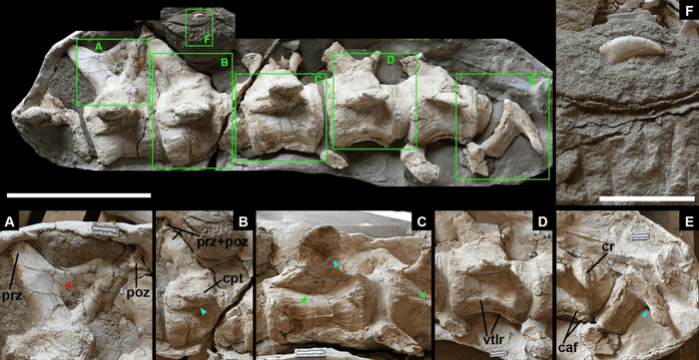
Holotype of Hamititan xinjiangensis gen. et sp. nov.IVPP
Also identified as a new species, the second specimen was christened Hamititan xinjiangensis. The recovered specimen consisted of seven vertebrae from the tail. According to the team, they could be from the fourth to tenth within the spine. Each of the vertebras was between 210–320 in length. Based on the shape and the ridges across vertebrae, the scientists conclude that it belonged to a family of sauropods called Titanosaurs.
Dinosaurs from the clade Titanosauria are known to have been abundant in Asia and South America. The authors estimated that this specimen was around 17m (55ft) in length. They arrived at the conclusion by comparing it to dinosaurs from what they assume to be closely related genera, Opisthocoelicaudia and Rapetosaurus.
Insights Into Reptilian Diversity
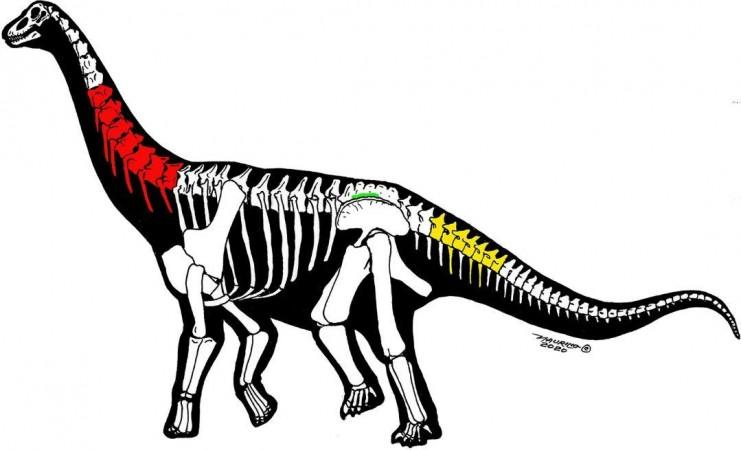
All specimens described in this paper shown in one outline of a generic titanosaur: preserved cervical elements of Silutitan sinensis gen. et sp. nov. (IVPP V27874) (red), preserved caudal elements of Hamititan xinjiangensis gen. et sp. nov. (HM V22) (yellow) and the preserved sacral elements (IVPP V27875) (green).MAURÍLIO OLIVEIRA
While not christened yet, the third specimen—only known as IVPP V27875—was also considered a new species. However, it consisted of four vertebrae and rib fragments. Based on their analysis, the authors suggest that it could also be a member of the clade Somphospondyli. Somphospondylan sauropods lived from the Late Jurassic period to the Late Cretaceous period (160.3 million years-, 66 million years ago).
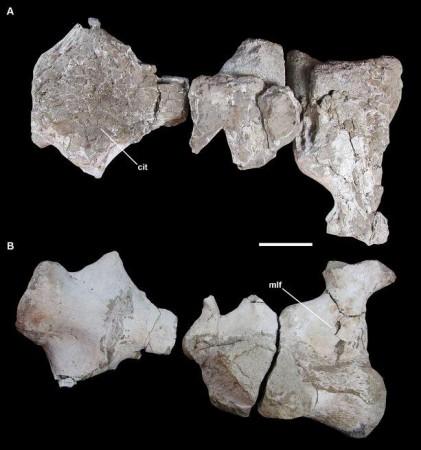
Sacral vertebrae (IVPP V27875), in (A) dorsal view, showing the camellate internal tissue (cit) and, (B) in ventral view, showing the mediolaterally deep fossa (mlf) on the ventral surface. Scale bar: 10 cm
WANG, XIAOLIN, ET AL/ SCIENTIFIC REPORTS
The discovered specimens are of special significance as they are some of the first dinosaurs found in the Turpan-Hami Basin; thereby adding to the diversity of Mesozoic (252-66 million years ago) reptiles found in the area.
"The discovery of Silutitan sinensis and Hamititan xinjiangensis increased the sauropod diversity of Asia, particularly from an area where these vertebrates are not common. Silutitan sinensis is closely related to Euhelopus. The existence of a more inclusive clade of similar sauropods (Euhelopodidae) is still a matter of debate and pends on more detailed description of some putative euhelopodid," wrote the authors.
The discovered specimens are of special significance as they are some of the first dinosaurs found in the Turpan-Hami Basin; thereby adding to the diversity of Mesozoic (252-66 million years ago) reptiles found in the area.
"The discovery of Silutitan sinensis and Hamititan xinjiangensis increased the sauropod diversity of Asia, particularly from an area where these vertebrates are not common. Silutitan sinensis is closely related to Euhelopus. The existence of a more inclusive clade of similar sauropods (Euhelopodidae) is still a matter of debate and pends on more detailed description of some putative euhelopodid," wrote the authors.

No comments:
Post a Comment